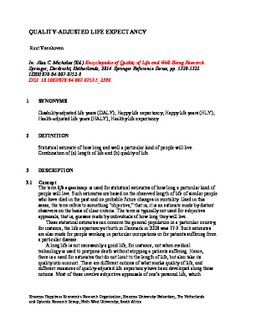2014
Quality Adjusted Life Expectancy
Publication
Publication
Abstract
The term life expectancy is used for statistical estimates of how long a particular kind of people will live. Such estimates are based on the observed length of life of similar people who have died in the past and on probable future changes in mortality. Used in this sense, the term refers to something “objective,” that is, it is an estimate made by distant observers on the basis of clear criteria. The term is typically not used for subjective appraisals, that is, guesses made by individuals of how long they will live. These statistical estimates can concern the general population in a particular country, for instance, the life expectancy at birth in Denmark in 2008 was 77.9. Such estimates are also made for people working in particular occupations or for patients suffering from a particular disease. A long life is not necessarily a good life, for instance, not when medical technology is used to postpone death without stopping a patients suffering. Hence, there is a need for estimates that do not limit to the length of life, but also take its quality into account. There are different notions of what marks quality of life, and different measures of quality-adjusted life expectancy have been developed along these notions. Most of these involve subjective appraisals of one’s personal life, which means that estimates of quality-adjusted life expectancy involve typically a mix of both objective and subjective assessments.
| Additional Metadata | |
|---|---|
| , , | |
| doi.org/10.1007/978-94-007-0753-5_2386, hdl.handle.net/1765/77261 | |
| Organisation | Department of Sociology |
|
Veenhoven, R. (2014). Quality Adjusted Life Expectancy. In Encyclopedia of Quality of Life and Well-Being Research (pp. 5320–5321). doi:10.1007/978-94-007-0753-5_2386 |
|

